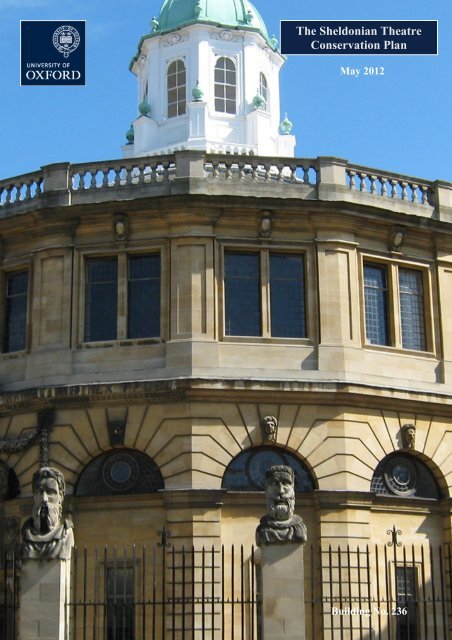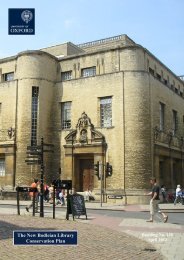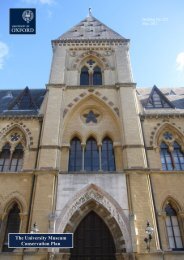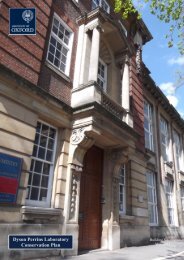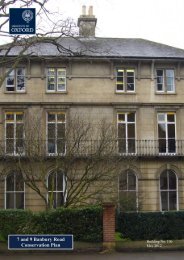The Sheldonian Theatre Conservation Plan - Central Administration ...
The Sheldonian Theatre Conservation Plan - Central Administration ...
The Sheldonian Theatre Conservation Plan - Central Administration ...
You also want an ePaper? Increase the reach of your titles
YUMPU automatically turns print PDFs into web optimized ePapers that Google loves.
<strong>The</strong> <strong>Sheldonian</strong> <strong>The</strong>atre<br />
<strong>Conservation</strong> <strong>Plan</strong><br />
May 2012<br />
<strong>Sheldonian</strong> <strong>The</strong>atre,<br />
<strong>Conservation</strong> <strong>Plan</strong>, May 2012<br />
1<br />
Building No. 236
Oxford University<br />
Estates Services<br />
First draft August 2010<br />
This draft May 2012<br />
<strong>Sheldonian</strong> <strong>The</strong>atre,<br />
<strong>Conservation</strong> <strong>Plan</strong>, May 2012<br />
2
THE SHELDONIAN THEATRE, OXFORD<br />
CONSERVATION PLAN<br />
CONTENTS<br />
1 INTRODUCTION 5<br />
1.1 Purpose of the <strong>Conservation</strong> <strong>Plan</strong> 5<br />
1.2 Scope of the <strong>Conservation</strong> <strong>Plan</strong> 6<br />
1.3 Existing Information 6<br />
1.4 Methodology 7<br />
1.5 Constraints 7<br />
2 UNDERSTANDING THE SITE 9<br />
2.1 History of the Site and University 9<br />
2.2 Construction and Subsequent History of the <strong>Sheldonian</strong> <strong>The</strong>atre 9<br />
3 SIGNIFICANCE OF THE SHELDONIAN THEATRE 13<br />
3.1 Significance as part of the city centre, Broad Street, and the 13<br />
<strong>Central</strong> (City and University) <strong>Conservation</strong> Area<br />
3.2 Significance as part of Oxford University’s monumental centre 13<br />
3.3 Historical Significance 15<br />
3.4 Archaeological Significance 15<br />
3.5 Architectural Significance 15<br />
3.6 Social Significance 18<br />
4 VULNERABILITIES 19<br />
4.1 <strong>The</strong> ability of the <strong>Sheldonian</strong> to fulfil its current function 19<br />
4.2 Exterior facing and setting 19<br />
4.3 Interior Fixtures and Fittings 20<br />
<strong>Sheldonian</strong> <strong>The</strong>atre,<br />
<strong>Conservation</strong> <strong>Plan</strong>, May 2012<br />
3
5 CONSERVATION POLICY 21<br />
6 BIBLIOGRAPHY 27<br />
7 APPENDICES 29<br />
Appendix 1: Listed Building Description 29<br />
Appendix 2: <strong>Conservation</strong> Area Description 31<br />
Appendix 3: Chronology of the <strong>Sheldonian</strong> <strong>The</strong>atre 35<br />
Appendix 4: Checklist of Significant Features 37<br />
<strong>Sheldonian</strong> <strong>The</strong>atre,<br />
<strong>Conservation</strong> <strong>Plan</strong>, May 2012<br />
4
1 INTRODUCTION<br />
<strong>The</strong> <strong>Sheldonian</strong> <strong>The</strong>atre was designed by Sir Christopher Wren and was built between<br />
1664 and 1669. It is a Grade I listed building and was described in 1994 by the<br />
European Commission as ‘one of the architectural jewels of Oxford’. <strong>The</strong> theatre is a<br />
functioning building, having operated as the primary assembly room of the University<br />
of Oxford since its construction, and recent redecoration work has restored the interior<br />
to something akin to its original character.<br />
1.1 Purpose of the <strong>Conservation</strong> <strong>Plan</strong><br />
<strong>The</strong> University has an unrivalled portfolio of historic buildings, of which it is rightly<br />
proud. It has traditionally taken a thorough, holistic approach to building<br />
conservation, seeking to understand all the varied factors that make historic buildings<br />
significant to their diverse stakeholders, and using this to inform necessary change. It<br />
has become clear that this approach is vital to the conservation culture of an<br />
institution where so many of its historic buildings that are valued for their function<br />
also have extensive historical or architectural significance. This <strong>Conservation</strong> <strong>Plan</strong><br />
represents the continuation of this tradition of seeking to understand what makes the<br />
University’s buildings cherished assets, and of seeking ways to conserve these most<br />
important features for the enjoyment of future generations.<br />
<strong>The</strong> success of this approach is such that it has now become codified in government<br />
policy: First in March 2010’s <strong>Plan</strong>ning Policy Statement 5: <strong>Plan</strong>ning for the<br />
Historical Environment then in its replacement, March 2012’s National <strong>Plan</strong>ning<br />
Policy Framework (hereafter: NPPF). NPPF provides useful guidance on approaching<br />
the conservation of heritage assets, and postdates the University’s existing literature.<br />
NPPF defines a heritage asset as:<br />
‘A building, monument, site, place, area or landscape identified as having a degree of<br />
significance meriting consideration in planning decisions, because of its heritage<br />
interest. Heritage asset includes designated heritage assets and assets identified by<br />
the local planning authority (including local listing).’<br />
This designation clearly applies to the <strong>Sheldonian</strong> <strong>The</strong>atre.<br />
<strong>The</strong> purpose of this <strong>Conservation</strong> <strong>Plan</strong> is to update the <strong>Sheldonian</strong> <strong>The</strong>atre’s<br />
conservation policy to take into account the new guidance provided by NPPF. It will<br />
be of use both for informing responsible regular maintenance and in the preparation of<br />
future planning applications, as specified in NPPF paragraph 128.<br />
<strong>The</strong> <strong>Conservation</strong> <strong>Plan</strong> should form the basis for the <strong>Sheldonian</strong> <strong>The</strong>atre’s<br />
<strong>Conservation</strong> Policy and exists as part of an ongoing process. It will be renewed and<br />
updated at least every five years or following any major alterations or legislative<br />
changes.<br />
<strong>Sheldonian</strong> <strong>The</strong>atre,<br />
<strong>Conservation</strong> <strong>Plan</strong>, May 2012<br />
5
1.2 Scope of the <strong>Conservation</strong> <strong>Plan</strong><br />
This <strong>Conservation</strong> <strong>Plan</strong> will cover the interior and exterior of the <strong>Sheldonian</strong> <strong>The</strong>atre,<br />
a single, self-contained building located on a raised pavement on the southern side of<br />
the eastern end of Broad Street, Oxford (see Figure 1).<br />
<strong>The</strong> plan is not a catalogue and in order to facilitate its practical use will concentrate<br />
only on the most vulnerable aspects of significance, suggesting how they should be<br />
approached and conserved in the future. A brief list of the most significant<br />
architectural elements can be found in the checklist in Appendix 4.<br />
1.3 Existing Information<br />
TFT Cultural Heritage produced a <strong>Conservation</strong> <strong>Plan</strong> for the <strong>Sheldonian</strong> <strong>The</strong>atre in<br />
June 2002; however this is a high-profile building and has undergone various periods<br />
of work since then. Recent planning applications have included Heritage Impact<br />
Statements, which provide a good introduction to the history and significance of the<br />
theatre. Applications 10/02206/LBC (Proposed Redecoration of the Main<br />
Auditorium) and 10/00955/LBC (Proposed Replacement of Lighting to Main<br />
Auditorium), both from 2010, contain useful Heritage Impact Statements that will<br />
form the basis for Section 2 and Section 3, and will inform Section 4 and Section 5.<br />
Application 10/02206/LBC also contains <strong>The</strong> <strong>Sheldonian</strong> <strong>The</strong>atre, Oxford:<br />
Auditorium and Circulation Spaces: Architectural Paint Research Archive Report, a<br />
report on the history of the interior paintwork prepared by the conservation<br />
consultancy Crick Smith (a commercial arm of the University of Lincoln). This<br />
provides a useful gazetteer of the extant decoration within the theatre, as well as a<br />
detailed history of its decoration and construction. This will form the basis of a major<br />
component of Section 2 and inform Section 3.<br />
A description of the <strong>Sheldonian</strong> <strong>The</strong>atre and its contents can be found in its listed<br />
building description, available from Oxford City Council. This explains the original<br />
basis for its grant of listed status and will inform Section 3.<br />
<strong>The</strong> <strong>Sheldonian</strong> <strong>The</strong>atre has been the major congregation room for the University of<br />
Oxford since its construction in 1669 and features in various histories of the<br />
University and city. Its history to 1954 is covered by: '<strong>The</strong> <strong>Sheldonian</strong> <strong>The</strong>atre', A<br />
History of the County of Oxford: Volume 3: <strong>The</strong> University of Oxford (1954), 50-54.<br />
This will inform Section 2.<br />
Broad Street, Oxford: <strong>The</strong> <strong>Plan</strong> was prepared by Kim Wilkie Associates on behalf of<br />
the Broad Street Steering Group in 2004. This sets out a series of short- to mediumterm<br />
plans for the regeneration of Broad Street, as well as providing valuable insight<br />
into the rôle of Broad Street (and its constituent elements) within the city as a whole.<br />
It will inform Section 2, Section 3, and Section 5.<br />
<strong>The</strong> plan draws on statutory guidance from NPPF prepared by HM’s Department for<br />
Communities and Local Government in March 2012. <strong>The</strong>se inform Section 3, Section<br />
4, and most notably Section 5.<br />
<strong>Sheldonian</strong> <strong>The</strong>atre,<br />
<strong>Conservation</strong> <strong>Plan</strong>, May 2012<br />
6
1.4 Methodology<br />
<strong>The</strong> <strong>Conservation</strong> <strong>Plan</strong> is a document that assesses the current and predicted<br />
conservation needs of the <strong>Sheldonian</strong> <strong>The</strong>atre and attempts to address them with a<br />
view towards maintaining or increasing the significance of the heritage asset. Its<br />
formulation to supersede any existing literature is a response to the requirements of<br />
NPPF, and it is prepared in accordance with the policies contained therein.<br />
1.5 Constraints<br />
<strong>The</strong> <strong>Sheldonian</strong> <strong>The</strong>atre and its environs are subject to various constraints imposed<br />
by Oxford City Council:<br />
<br />
<br />
<br />
<br />
<br />
<br />
HE.2 – Archaeology Area: Any planning application must incorporate<br />
sufficient information to define the character and extent of potential<br />
archaeological deposits, including the results of fieldwork evaluations.<br />
CP.3 – Limiting the Need to Travel: New development will be limited to<br />
accessible locations on previously developed sites.<br />
HE.9 – High Building Areas: <strong>Plan</strong>ning permission will not be granted for any<br />
development within a 1,200 metre radius of Carfax which exceeds 18.2m in<br />
height, except for minor elements of no bulk.<br />
TR.3, TR.11, TR.12 – Car Parking Standards: <strong>The</strong> City Council will not allow<br />
any significant increase in the overall number of car-parking spaces in the<br />
Transport <strong>Central</strong> Area or development that provides an inappropriate level of<br />
car-parking spaces. It will attempt to reduce the level of non-residential car<br />
parking.<br />
<strong>The</strong> City of Oxford Smoke Control Order No. 1: It is an offence to emit smoke<br />
from the chimney of a building, from a furnace, or from any fixed boiler if<br />
located in a designated smoke control area.<br />
HE.7 – <strong>Conservation</strong> Areas: <strong>The</strong> <strong>Central</strong> (City and University) <strong>Conservation</strong><br />
Area: <strong>Plan</strong>ning permission will only be granted for development that preserves<br />
or enhances the special character and appearance of the conservation areas or<br />
their setting. All trees in <strong>Conservation</strong> Areas with stem diameters greater than<br />
75mm at 1.5m off the ground are protected.<br />
<strong>Sheldonian</strong> <strong>The</strong>atre,<br />
<strong>Conservation</strong> <strong>Plan</strong>, May 2012<br />
7
Figure 1. <strong>Sheldonian</strong> site plan, with <strong>Sheldonian</strong> theatre marked in dark red and<br />
the Bodleian buildings marked in pale red<br />
<strong>Sheldonian</strong> <strong>The</strong>atre,<br />
<strong>Conservation</strong> <strong>Plan</strong>, May 2012<br />
8
2 UNDERSTANDING THE SITE<br />
2.1 History of the Site and University<br />
<strong>The</strong> University of Oxford has a long-standing tradition of exceptional education. Able<br />
to trace its roots to the 11 th Century, it is known to be the oldest university in the<br />
English-speaking world. <strong>The</strong> <strong>Sheldonian</strong> <strong>The</strong>atre stands on the eastern end of Broad<br />
Street, the monumental centre of the city and the University. Broad Street has a long<br />
history and was initially peripheral to the mediaeval settlement, being known as<br />
Canditch as it was defined by houses constructed along a ditch outside the city walls.<br />
However, Henry II granted Oxford its charter in 1155, and with the formal<br />
recognition of the University, Catte Street and the eastern end of Broad Street became<br />
the centre of a small area of ‘schools’ set up in tenements, which in turn attracted<br />
scholars from across Europe. Various colleges sprang up in the area during the late<br />
middle ages, notably Balliol in 1263, and with the building of the Divinity School and<br />
Duke Humphrey’s Library in 1487, the focus of the University settled on this part of<br />
the city.<br />
Since then the principal non-collegiate buildings of the University have been situated<br />
in a cluster around the eastern end of Broad Street, including the <strong>Sheldonian</strong> <strong>The</strong>atre<br />
itself (1669), the Old Ashmolean (1678-83), the Clarendon Building (1711-13), the<br />
Indian Institute (1884-96), and the New Bodleian Library (1937-40). <strong>The</strong> Old<br />
Bodleian Library (1602-1637) interacts with the space through the arch of the<br />
Clarendon Building. In 1703 Hawksmoor proposed the formation of a formal<br />
university campus at the eastern end of Broad Street. Whilst this never officially<br />
occurred, a similar effect has been achieved almost by default, with the urban space of<br />
eastern Broad Street being defined by University buildings, and being a focus for<br />
ceremonies, protests, tourism, and gatherings.<br />
In April 1971 Oxford City Council designated the majority of the city centre as part of<br />
the <strong>Central</strong> (City and University) <strong>Conservation</strong> area, focused on Broad Street East, the<br />
<strong>Sheldonian</strong> <strong>The</strong>atre, and the Bodleian complex (see Appendix 2).<br />
2.2 Construction and Subsequent History of the <strong>Sheldonian</strong> <strong>The</strong>atre<br />
<strong>The</strong> <strong>Sheldonian</strong> <strong>The</strong>atre was originally designed as, and remains to this day, the<br />
principal assembly room of the University, and regular meeting-place of<br />
Congregation, the body of resident Masters of Arts which controls the University’s<br />
affairs. <strong>The</strong> building was also originally designed to accommodate the University<br />
Press (who subsequently relocated to the neighbouring Clarendon Building in 1713).<br />
It was constructed between 1664 and 1669, funded by Gilbert Sheldon, Warden of All<br />
Souls College and later Archbishop of Canterbury, and was the first major design of<br />
Sir Christopher Wren (1632-1723). <strong>The</strong> Master Mason and builder was Thomas<br />
Robinson.<br />
<strong>The</strong> original roof also incorporated ingeniously constructed timber trusses and<br />
complicated cross beams, supported by only braces and screws, without any columns,<br />
spanning the 70 foot (21.34 metres) by 80 foot (24.38 metres) auditorium.<br />
<strong>Sheldonian</strong> <strong>The</strong>atre,<br />
<strong>Conservation</strong> <strong>Plan</strong>, May 2012<br />
9
Wren’s original roof was however rebuilt by George Saunders, architect to Oxford<br />
University, in 1801-2, with the existing cupola being redesigned by Edward Blore in<br />
1838.<br />
More recently, in 2007, the slated roofs (covered with green Westmoreland slates)<br />
were overhauled, in advance of the reinstatement of the ceiling paintings, following<br />
their conservation and repair off site. <strong>The</strong> restored paintings were back in place by<br />
November 2008.<br />
Various parts of the external elevations have been refaced over the years with repairs<br />
being known to have been carried out in 1826, 1838, and 1911. During the 1958-63<br />
restoration projects, undertaken in three phases under the supervision of W. Godfrey<br />
Allen, further extensive repairs were carried out to the stonework, including the<br />
complete refacing of all elevations and the rebuilding of the parapet and balustrading<br />
at roof level.<br />
Wren’s original windows were first replaced with “Georgian” timber sash windows in<br />
1767-68 but during the major restoration works in 1958-3 new (current) oak windows<br />
were installed; the new windows being similar (but not identical) in design to Wren’s<br />
original.<br />
Internally, in 1935-37, the timber structure supporting the galleries around the<br />
Auditorium was found to be in poor condition and a steel frame was inserted to<br />
provide suitable support.<br />
To facilitate this work the balcony fronts were temporarily dismantled and the timber<br />
panelling and seating were removed and subsequently reinstated following installation<br />
of the new steel “skeleton” structure. <strong>The</strong> plastered vaults over the Ladies’ Gallery<br />
were also stripped out and subsequently replastered.<br />
Further improvements were also carried out at that time, including the introduction of<br />
electrical power and electric lighting.<br />
In 1962-63, as part of the final phase of the major three-phase restoration project, the<br />
original timber floor of the auditorium was replaced with a new reinforced concrete<br />
“coffered” floor.<br />
In 2009, the discovery of boarding containing asbestos required numerous internal<br />
window boards to be removed and replaced, although the affected boards were not<br />
original: having been replaced previously during the restoration work by W. Godfrey<br />
Allen in 1961-63.<br />
<strong>The</strong> existing brass and crystal glass fittings were installed in 1961-63, replacing the<br />
only previous lighting installation (dating from 1935-37), when electricity was first<br />
introduced into the building. <strong>The</strong> chandeliers, wall-mounted scones, candelabras, and<br />
pendant fittings would appear to have been a compromise solution and did not<br />
provide a satisfactory level or quality of illumination for performers using the theatre.<br />
<strong>The</strong>se were replaced with subtle recessed lighting and improved spot-lighting in 2010.<br />
<strong>Sheldonian</strong> <strong>The</strong>atre,<br />
<strong>Conservation</strong> <strong>Plan</strong>, May 2012<br />
10
A new paint scheme was also completed in 2010; this replaced the last decorative<br />
scheme (completed in the early 1960s) with one more akin to the understated<br />
refinement of Wren’s original design. This included removing much of the fauxmarbling<br />
that had come to dominate the interior, and reintroducing: grey wainscot<br />
panelling; a ‘Cedar’ finish to the seating; dark red ‘Rouge de Rance’ marbling to the<br />
columns (blending with one another and the background to create the illusion of a<br />
‘floating’ upper gallery, unsupported from below); and a ‘Stone’ colour to the Lower<br />
Gallery fronts and Upper Gallery balcony fronts.<br />
<strong>Sheldonian</strong> <strong>The</strong>atre,<br />
<strong>Conservation</strong> <strong>Plan</strong>, May 2012<br />
11
THIS PAGE HAS BEEN LEFT BLANK<br />
<strong>Sheldonian</strong> <strong>The</strong>atre,<br />
<strong>Conservation</strong> <strong>Plan</strong>, May 2012<br />
12
3 SIGNIFICANCE OF THE SHELDONIAN THEATRE<br />
NPPF paragraph 128 specifies that in assessing planning applications:<br />
‘Local planning authorities should require an applicant to provide a description of<br />
the significance of any heritage assets affected including any contribution made by<br />
their setting.’<br />
<strong>The</strong> significance of the <strong>Sheldonian</strong> <strong>The</strong>atre has been publically recognised by two<br />
statutory designations: It was designated a Grade I Listed building in 1954 (see<br />
Appendix 1); and it was included in Oxford City Council’s designation of the <strong>Central</strong><br />
(City and University) <strong>Conservation</strong> Area in 1971, and in its subsequent revisions in<br />
1974, 1981, 1985, and 1998 (see Appendix 2). 1<br />
3.1 Significance as part of the city centre, Broad Street, and the <strong>Central</strong> (City and<br />
University) <strong>Conservation</strong> Area<br />
As mentioned above (Section 2.1) Broad Street East forms the monumental core of<br />
the city of Oxford, and is the city’s major civic meeting space. Oxford is one of the<br />
most visited places in the UK, and Broad Street is the focus for the visitor’s<br />
experience. It is one of the most renowned and beautiful streets in Europe, with an<br />
architectural and cultural heritage that deserves World Status.<br />
<strong>The</strong> <strong>Sheldonian</strong> is significant as a major contributing factor to the drama of this space,<br />
which is so integral to the significance of the <strong>Central</strong> (City and University)<br />
<strong>Conservation</strong> Area as a whole. Its curve can be seen from the western end of Broad<br />
Street and it draws the eye at least as much as the Bodleian buildings around it. As an<br />
iconic feature of Oxford University, the <strong>Sheldonian</strong> is second in stature only to the<br />
Radcliffe Camera.<br />
<strong>The</strong> theatre is open to the public and is a major focus for tourism, with its presence<br />
enlivening the area. <strong>The</strong>re is public access to the cupola, which is a bland space in<br />
itself but has fantastic views north across Broad Street and south over the Bodleian<br />
that can be enjoyed by a wide audience. <strong>The</strong> <strong>Sheldonian</strong> is a venue for public artistic<br />
and musical performances, and so contributes to the culture and night life of Broad<br />
Street and the city centre in general.<br />
3.2 Significance as part of Oxford University’s monumental centre<br />
3.2.1 Significance of relationship with the Bodleian Complex<br />
<strong>The</strong> <strong>Sheldonian</strong> is not part of the Bodleian Library, but its location and design cause it<br />
to interact with the library buildings around it. <strong>The</strong> Broad Street elevation is actually<br />
the rear curve of the <strong>Sheldonian</strong>, with the main entrance as Wren intended facing<br />
directly onto the Divinity Schools of the Old Bodleian. This forms a quadrangle<br />
between the two which is central to both the character of the area and to the<br />
University’s ceremony, with graduands changing robes in the Divinity Schools and<br />
then congregating in this quadrangle before entering the <strong>Sheldonian</strong> to graduate.<br />
1 <strong>The</strong> external railings and boundary wall were also designated as Grade I listed in 1972.<br />
<strong>Sheldonian</strong> <strong>The</strong>atre,<br />
<strong>Conservation</strong> <strong>Plan</strong>, May 2012<br />
13
Equally, the eastern elevation of the <strong>Sheldonian</strong> forms the western perimeter of a<br />
quadrangle bounded by: the southern elevation of the Clarendon Building to the north;<br />
by the northern elevation of the Old Bodleian Library to the south; and by Catte Street<br />
to the east. This is an open area of unrivalled character enjoyed by readers, tourists,<br />
and film crews alike (see Figure 2). <strong>The</strong>se areas have become vital for the enjoyment<br />
and character of this space.<br />
N<br />
Figure 2. <strong>Plan</strong> of <strong>Sheldonian</strong> and some of the Bodleian complex showing<br />
quadrangles created by the placement of the <strong>Sheldonian</strong><br />
3.2.2 Significance as the focus for University ceremony<br />
As mentioned above (Section 1.1, Section 2.2, and Section 3.2.1) the <strong>Sheldonian</strong><br />
forms the major ceremonial space for the University. It is the location for<br />
Matriculation and Graduation ceremonies, so forms a memorable and important<br />
aspect of every student’s experience of Oxford. Members of the public also enjoy<br />
congregating outside during such occasions in order to experience the much-lauded<br />
spectacle.<br />
<strong>The</strong> <strong>Sheldonian</strong> is the regular meeting-place of Congregation, the body of resident<br />
Masters of Arts which governs the University, and has played an important rôle in the<br />
public life of the institution since its construction in 1669.<br />
<strong>Sheldonian</strong> <strong>The</strong>atre,<br />
<strong>Conservation</strong> <strong>Plan</strong>, May 2012<br />
14
3.3 Historical Significance<br />
<strong>The</strong> long history of the <strong>Sheldonian</strong> <strong>The</strong>atre is summarised above (Section 2.2 and<br />
Section 2.3) and is clearly a major component of its significance as a heritage asset.<br />
As the meeting-place of the Congregation, from its construction the history of the<br />
<strong>Sheldonian</strong> is synonymous with the history of the University.<br />
<strong>The</strong> list of distinguished alumni who matriculated and graduated within this building<br />
is too long to quote, but includes prominent historical and literary figures such as: Sir<br />
Robert Peel the Younger; William Ewart Gladstone; Edward VII; Clement Attlee;<br />
Tony Benn; T.E. Lawrence; Philip Larkin; Iris Murdoch; Mary Renault; and J.R.R.<br />
Tolkien; as well as countless prominent academics. <strong>The</strong> numerous notable historical<br />
figures that have had even this passing acquaintance with the <strong>Sheldonian</strong> make it one<br />
of the nation’s foremost historical buildings.<br />
<strong>The</strong> <strong>Sheldonian</strong> is also significant as the location of the premier of Handel’s oratorio<br />
Athalia on the 10 th July 1733, which was conducted in person by the composer<br />
himself. This marks its significance in the history of music, and it continues to be an<br />
important location for live performances to this day.<br />
<strong>The</strong> history of the <strong>Sheldonian</strong> is remarkably well recorded throughout its lifespan,<br />
beginning with the logs recording the payment of the works responsible for its initial<br />
construction. <strong>The</strong> Bodleian Library contains a wealth of information on the<br />
<strong>Sheldonian</strong>, allowing one to trace the construction history of the building to an<br />
astonishing degree. This makes it a significant resource for the study of historical<br />
building methods.<br />
3.4 Archaeological Significance<br />
<strong>The</strong> <strong>Sheldonian</strong> is built on the location of several houses dating from the first half of<br />
the Seventeenth Century or earlier. <strong>The</strong>se were demolished for its construction but,<br />
whilst the building does have cellars, there is likely to be some extant subterranean<br />
archaeological material relating to them; moreover, the areas beneath and around the<br />
<strong>Sheldonian</strong> no doubt hold archaeological material related to the construction of the<br />
<strong>The</strong>atre itself. During excavations in 1962-63, the city ditch, infilled in the 17 th<br />
century, was found to run through and to the northwest of the <strong>Sheldonian</strong>.<br />
Whilst the paved area around the <strong>Sheldonian</strong> has been reconfigured on numerous<br />
occasions, the area has a continuous history of occupation since at least the Eleventh<br />
Century, and the probable depth of the relevant stratigraphic layers would suggest that<br />
it is likely that significant material may be extant.<br />
3.5 Architectural Significance<br />
3.5.1 Wren<br />
<strong>The</strong> <strong>Sheldonian</strong> <strong>The</strong>atre was the first major commission of Sir Christopher Wren<br />
(1632-1723), although it was completed after his second, the design for the chapel of<br />
Pembroke College, Cambridge, finished in 1663. <strong>The</strong> <strong>Sheldonian</strong> <strong>The</strong>atre employs a<br />
combination of classical design (based loosely upon the first-century <strong>The</strong>atre of<br />
<strong>Sheldonian</strong> <strong>The</strong>atre,<br />
<strong>Conservation</strong> <strong>Plan</strong>, May 2012<br />
15
Marcellus in Rome, dedicated by Augustus in 12 BC) and seventeenth-century<br />
empiricism. <strong>The</strong> roof and ceiling replace the open-air design of the Roman theatre.<br />
<strong>The</strong>se were constructed using an innovative design involving timber trusses and<br />
complicated cross beams to avoid having to limit the width of the building according<br />
to the size of available roofing beams.<br />
Figure 3. Sir Christopher Wren in 1711 (aged 79)<br />
Wren is now recognised as one of the finest architects ever to have lived, with his<br />
numerous commissions including: St. Paul’s Cathedral; the Greenwich Royal<br />
Observatory; Hampton Court Palace; the Royal Hospital Chelsea; and over 50<br />
churches in London. He went on to become the “King’s Surveyor of Works” for<br />
Charles II. <strong>The</strong> <strong>Sheldonian</strong> remains significant as a remarkable and near-complete<br />
example of Wren’s work.<br />
3.5.2 Preservation of the <strong>Sheldonian</strong><br />
<strong>The</strong> <strong>Sheldonian</strong> is in remarkably good condition and, whilst it was refaced in 1958-<br />
63, the exterior retains Wren’s original design, including the distinctive round<br />
windows. Of the exterior only the loss of the elliptical dormer windows and the<br />
enlarged cupola, built in 1838 under Edward Blore, detract from Wren’s original<br />
design.<br />
On the interior, the colour scheme has recently been restored to its original state,<br />
replacing the previous scheme which dated from the Nineteenth and Twentieth<br />
Centuries and was rather brighter than Wren’s scheme; moreover, the intrusive light<br />
<strong>Sheldonian</strong> <strong>The</strong>atre,<br />
<strong>Conservation</strong> <strong>Plan</strong>, May 2012<br />
16
fittings that hung within the theatre were replaced with recessed lighting (in the<br />
window sills) and subtle spotlighting. <strong>The</strong>se minor alterations have meant that, other<br />
than the organ housing (dating from 1876) and the emergency exit signs (and other<br />
necessities of modern utility), the character and atmosphere of the building are now<br />
much as they would have been in 1669 (Figure 4). 2<br />
.<br />
Figure 4. <strong>The</strong> interior of the <strong>Sheldonian</strong>, showing Wren’s original colour scheme<br />
(restored in 2011) on the left and the nineteenth-century colour scheme and<br />
intrusive twentieth-century light fittings on the right. Note the heavy marbling<br />
on the balconies on the right-hand side, and how on the left-hand side the darker<br />
pillars blend in with the background.<br />
2 All documentary evidence denotes a date of 1876, but the dedication on the organ itself states 1877.<br />
<strong>Sheldonian</strong> <strong>The</strong>atre,<br />
<strong>Conservation</strong> <strong>Plan</strong>, May 2012<br />
17
3.5.3 Ceiling Paintings<br />
<strong>The</strong> ceiling paintings were completed in 1668 by Robert Streeter, the serjeant-painter<br />
to the court of Charles II. <strong>The</strong> allegorical programme in the paintings shows Truth<br />
descending upon the Arts and Sciences to expel Ignorance from the University. <strong>The</strong>y<br />
were repaired or restored by Tilley Kettle in 1762, in 1802 by William Delamotte, and<br />
perhaps in 1826 by Dixon. Since the 1870s a major thematic element of the scene, the<br />
villainous figure of Ignorance, has been obscured beneath T.G. Jackson’s organ<br />
housing. <strong>The</strong> paintings were most recently restored in 2004-08 by International Fine<br />
Arts <strong>Conservation</strong> Studios Ltd., Bristol. <strong>The</strong>y have been a feature of the building<br />
since shortly after its construction and contribute significantly to the character of the<br />
<strong>Sheldonian</strong> (see Figure 5).<br />
3.6 Social Significance<br />
Figure 5. <strong>The</strong> restored ceiling<br />
It has been noted above (see Section 3.1) how the <strong>Sheldonian</strong> makes a significant<br />
contribution to the character of the area. It is also significant as the venue for live<br />
performances of classical music, being regularly granted public performance licenses<br />
by Oxford City Council. This contributes to the cultural life of the city and to the local<br />
economy, as the theatre’s patrons tend to also visit local pubs and restaurants. It is<br />
also the setting for public lectures of some significance, for instance the Romanes<br />
Lecture given by the then Prime Minister Gordon Brown on 27 th February 2009.<br />
<strong>Sheldonian</strong> <strong>The</strong>atre,<br />
<strong>Conservation</strong> <strong>Plan</strong>, May 2012<br />
18
4 VULNERABILITIES<br />
4.1 <strong>The</strong> ability of the <strong>Sheldonian</strong> to fulfil its current function<br />
<strong>The</strong> <strong>Sheldonian</strong>’s current function as the main public chamber of Oxford University<br />
and as a public music venue is its optimum viable use.<br />
<strong>The</strong> <strong>Sheldonian</strong> was designed for this function and, other than the need for electrical<br />
amplification and lighting, the requirements for staging classical music performances<br />
have not changed greatly since 1669. <strong>The</strong> alterations that have been required of this<br />
building for its current function are no greater than those that would be required for<br />
any form of modern utility, i.e. those related to electricity provision, adequate<br />
plumbing, lavatory accommodation, housing staff, and disabled access. Without<br />
requiring alterations, the current use funds the upkeep and conservation of the<br />
heritage asset and ensures its continued existence and significance.<br />
<strong>The</strong> retention of this function is vital to the continued significance of the <strong>Sheldonian</strong>.<br />
In order to retain this use it must continue to meet modern standards of health and<br />
safety and fire safety. Its fire exits are limited by the original design to the 6 groundfloor<br />
doors (only 3 of which are immediately accessible from the auditorium) and 1<br />
basement-level exit. <strong>The</strong> raised galleries pose a risk to users in the event of an<br />
emergency as they have no direct means of egress and must be accessed via stairs<br />
from the ground floor. <strong>The</strong> cupola and roof space are publically accessible but have<br />
no direct escape routes, and must be exited via a series of wooden staircases some of<br />
which are relatively narrow.<br />
4.2 Exterior facing and setting<br />
<strong>The</strong> exterior facing is relatively modern (1958-63) but follows Wren’s original design<br />
and is central to the significance of the exterior of the building, as it comprises the<br />
majority of the iconic views of the <strong>Sheldonian</strong> from Broad Street and Catte Street.<br />
<strong>The</strong>se are exposed to weathering, erosion, and potential vandalism, damage which<br />
could detract from the significance of the heritage asset.<br />
<strong>The</strong> slated roof was replaced in 2007 and should be adequate for the foreseeable<br />
future, but will be vulnerable to unexpected or extreme weather conditions.<br />
<strong>The</strong> ongoing alteration of the New Bodleian (forecasted to finish in 2015) will<br />
eventually change the character of the eastern end of Broad Street, encouraging<br />
greater public interface with the buildings. This will affect the nature of the<br />
<strong>Sheldonian</strong>’s interaction with this space and should be monitored; however, the net<br />
impact on the <strong>Sheldonian</strong>’s significance will be positive as the alterations will<br />
encourage a greater public enjoyment of the space.<br />
4.3 Interior Fixtures and Fittings<br />
Few of the fixtures and fittings are original (though original features are no doubt<br />
extant beneath later restoration and alteration) but, whilst most are not, the majority of<br />
them have some architectural and historical significance, e.g. Sir Thomas Jackson’s<br />
organ housing dating from 1876; moreover, the atmosphere and character they create<br />
<strong>Sheldonian</strong> <strong>The</strong>atre,<br />
<strong>Conservation</strong> <strong>Plan</strong>, May 2012<br />
19
are integral to the significance of the <strong>Sheldonian</strong> as a heritage asset (see Section<br />
3.5.2). As they are in regular use and of less permanent construction than the external<br />
structure of the building, they are more vulnerable to vandalism, accidents, and<br />
general wear and tear. Some of these issues should be mitigated assuming adequate<br />
security is in place, but ultimately these significant elements will have limited<br />
lifespans. <strong>The</strong>se lives can be lengthened as much as possible through regular,<br />
adequate monitoring and maintenance.<br />
As a Grade I listed building any interior alterations, or repairs made with non-original<br />
materials, will require listed building consent.<br />
4.3.1 Ceiling Paintings<br />
<strong>The</strong> significance of the ceiling paintings has been established above (see Section<br />
3.5.3). <strong>The</strong>se have recently undergone extensive restoration, but because of their age<br />
and quality will always remain a vulnerable feature; fortunately they are inaccessible<br />
and safe from most accidental harm, but they are inevitably susceptible to craquelure<br />
and environmental deterioration, and are particularly vulnerable to fire/smoke<br />
hazards. Due to their location, the ceiling paintings will be vulnerable to water<br />
damage from any roof leaks that may occur (see Section 4.2).<br />
<strong>Sheldonian</strong> <strong>The</strong>atre,<br />
<strong>Conservation</strong> <strong>Plan</strong>, May 2012<br />
20
5 CONSERVATION POLICY<br />
Having established the significance of the <strong>Sheldonian</strong> <strong>The</strong>atre as a heritage asset, and<br />
having identified ways in which the significance of the <strong>Sheldonian</strong> is vulnerable to<br />
harm, it is necessary to recommend policies to reduce the probability of such harm<br />
occurring and thereby conserve the significance of the site. In essence, these policies<br />
set parameters for managing the fabric of the site.<br />
<strong>The</strong> <strong>Conservation</strong> <strong>Plan</strong> is intended as an active tool for the regular maintenance and<br />
long-term management of the <strong>Sheldonian</strong> <strong>The</strong>atre. It needs to be reviewed regularly,<br />
and revised as appropriate to take account of additional knowledge and changing<br />
priorities. Through a process of regular review it should continue to act as a useful<br />
resource.<br />
5.1 <strong>The</strong> <strong>Sheldonian</strong>’s current use, as the primary ceremonial space for the<br />
University of Oxford and as a public music venue, is its optimum viable use.<br />
Permit, in line with NPPF paragraphs 131, 132, 133, and 134, alterations<br />
intended to facilitate its continued use in this way<br />
<strong>The</strong> significance of the <strong>Sheldonian</strong> as the primary ceremonial space for the University<br />
of Oxford means that its current rôle represents its optimum viable use. In line with<br />
modern standards it can continue to fulfil this function without alteration, however if<br />
alteration is required in the future it should be permitted with the following provisos:<br />
<br />
Any alterations must be sympathetic to the <strong>Sheldonian</strong>’s significance as a heritage<br />
asset and, in line with NPPF paragraph 134, any proposals that involve ‘less than<br />
substantial harm to the significance’ should deliver ‘substantial public benefits.’<br />
In line with NPPF paragraph 132, any proposals that involve ‘substantial harm or<br />
loss’ should be ‘wholly exceptional.’<br />
Any changes should: ‘…preserve those elements of the setting that make a positive<br />
contribution to or better reveal the significance of the asset’ (NPPF paragraph 137).<br />
5.1.1 Note that the <strong>Sheldonian</strong> <strong>The</strong>atre is a Grade I listed building and ensure that<br />
appropriate consents are obtained for any alteration works to the interior or<br />
exterior of the building<br />
<strong>The</strong> upcoming alterations should preclude the need for any significant changes in the<br />
near future, but due to the listed status of the building even minor routine repairs may<br />
need consent. Caution should be applied in order to ensure that any statuary duties are<br />
fulfilled. In cases of doubt Estates Services should be contacted in the first<br />
instance, and if necessary they will refer queries on to Oxford City Council.<br />
<strong>Sheldonian</strong> <strong>The</strong>atre,<br />
<strong>Conservation</strong> <strong>Plan</strong>, May 2012<br />
21
5.1.2 Ensure proper consultation in advance of any work to the building with the<br />
Local Authority <strong>Conservation</strong> Officer and any other interested parties<br />
It is important to guarantee that the best advice is obtained at an early stage of any<br />
proposal to alter any part of the building in order to ensure that the significance of the<br />
building is respected.<br />
5.1.3 Refer to this <strong>Conservation</strong> Guide when considering repairs or alterations in any<br />
space<br />
<strong>The</strong> <strong>Conservation</strong> <strong>Plan</strong> gives an overview of which aspects of the building are<br />
significant or vulnerable. Where original or significant material is extant, repairs<br />
should be carried out using the same materials and techniques and should not affect<br />
the significance of the asset without providing substantial public benefits in line with<br />
NPPF paragraph 134.<br />
5.2 In order to ensure that the <strong>Sheldonian</strong> can operate to modern standards, and<br />
that its significance can be maintained by making access as wide as possible,<br />
special concern should be applied to ensuring that disabled access is adequate<br />
Ensuring that the heritage asset can be enjoyed as widely as possible will have a<br />
major positive impact on its significance. Alterations in 1988, 1993, and 1997 (see<br />
Section 2.3) made aspects of the building more accessible (including external ramps<br />
and disabled lavatories) and this should be approached as part of an ongoing process.<br />
5.3 Any redevelopment needs to respect the <strong>Conservation</strong> Area and the <strong>Sheldonian</strong>’s<br />
setting adjacent to several important listed buildings<br />
It has been established that the <strong>Sheldonian</strong> is significant as an integral aspect of the<br />
University’s monumental centre at Broad Street East, possessing an important spatial<br />
relationship with the Bodleian Complex. Any future alteration should be sympathetic<br />
to this fact, and should not diminish its rôle there.<br />
5.4 <strong>Conservation</strong> of specific features contributing to overall significance<br />
A great deal of the interior fixtures and fittings have some historical significance (see<br />
Section 4.3). <strong>The</strong>se finishes should be identified and conserved and kept in use where<br />
possible in line with Section 5.1. It is accepted, however, that all these materials have<br />
a natural life span and some degree of change must be permitted to keep the building<br />
safe, useable, and generally fit for its primary purpose as a working theatre. Some<br />
materials such as the external stone elevations have a very long life expectancy if<br />
given minor maintenance; others such as the paint work have undergone various<br />
incarnations (the theatre has now enjoyed 8 separate paint schemes) and will need<br />
periodic replacement. Within the framework of understanding and valuing what is<br />
present in the building a degree of ongoing change is inevitable.<br />
<strong>Sheldonian</strong> <strong>The</strong>atre,<br />
<strong>Conservation</strong> <strong>Plan</strong>, May 2012<br />
22
5.4.1 <strong>The</strong> exterior elevations will remain substantially unchanged<br />
<strong>The</strong> extant facing of the exterior elevations of the <strong>Sheldonian</strong> <strong>The</strong>atre date from 1958-<br />
63 and are sympathetic to the original design. <strong>The</strong> exterior view of the <strong>Sheldonian</strong> is<br />
vital to its significance as part of the monumental complex at Broad Street East and as<br />
an iconic Oxford landmark. Changes to these elevations would substantially affect the<br />
character of the building. <strong>The</strong>y will remain unchanged from their initial design,<br />
allowing for restoration and repair work as required. <strong>The</strong> recent interior lighting<br />
alterations have successfully highlighted some of the external features of the building<br />
without detracting from its character.<br />
5.4.2 <strong>The</strong> interior will remain largely unchanged<br />
<strong>The</strong> character of the interior of the building is vital to its significance. Successful<br />
recent alterations have returned the interior of the theatre to a state close to its original<br />
character, enhancing its significance as a heritage asset. With this in mind, and taking<br />
into account the allowances made in Section 5.1, the interior will remain largely<br />
unchanged from its current state, allowing for restoration and repair work as required.<br />
A notable exception remains the parquet floor of the auditorium, which is a recent<br />
addition and not of significance.<br />
5.4.3 Robert Streeter’s restored ceiling paintings are integral to the character and<br />
significance of the heritage asset and will remain largely unchanged<br />
<strong>The</strong> ceiling paintings are now in something akin to their original condition and<br />
contribute significantly to the character of the space, drawing the eye immediately<br />
upon entrance. Beyond their artistic significance, their bright and hopeful demeanour<br />
contributes to the sense of light and openness required by the bouleuterion-influenced<br />
design and facilitated by the ample windows and clear central space. Loss or<br />
alteration of these would negatively affect the character of the space and they will be<br />
retained in situ and conserved as required.<br />
5.5 In the vein of NPPF paragraph 110, efforts should be made to ensure that the<br />
<strong>Sheldonian</strong> <strong>The</strong>atre’s contribution to climate change is as minimal as is feasible<br />
for a building of its age, size, materials, and use. Any proposals for alterations<br />
should assess the feasibility of incorporating low and zero carbon technologies<br />
Ensuring that the building is sustainable will be crucial to its long-term survival and<br />
significance. As stated in NPPF paragraph 110, development should seek to<br />
‘minimise pollution and other adverse effects on the local and natural environment.’<br />
5.6 A disaster recovery plan will be prepared for the building and will be regularly<br />
reviewed to keep it up to date<br />
This is a significant building with internal contents of particular value and<br />
significance. It is imperative for the safety of the building that a clear disaster<br />
recovery plan exists.<br />
<strong>Sheldonian</strong> <strong>The</strong>atre,<br />
<strong>Conservation</strong> <strong>Plan</strong>, May 2012<br />
23
5.6.1 <strong>The</strong> provision of emergency escape routes from the cupola, roof space, and<br />
galleries should be reviewed and if necessary improved<br />
<strong>The</strong>se spaces are publically accessible but are difficult to escape in the event of<br />
emergency as the exits are all located on the ground floor or basement level. <strong>The</strong><br />
feasibility of improving the provision of emergency exits without causing substantial<br />
harm to the significance of the heritage asset should be reviewed.<br />
5.7 If during subsequent renovations or alterations any evacuation work is carried<br />
out beneath the <strong>Sheldonian</strong> or surrounding paved area an archaeological<br />
assessment will be made of the potential for significant finds, and if appropriate<br />
an archaeologist will be given a watching brief as the excavation takes place<br />
<strong>The</strong>re is the potential for significant archaeological material across the site and should<br />
any evacuation work be carried out an assessment of the archaeological potential<br />
should be made. This should include at least a desk assessment, but possibly<br />
geophysics and trial trenching. A watching brief will almost certainly be required for<br />
any such work.<br />
5.8 A good practice of routine recording, investigation, and maintenance will be<br />
enacted and sustained. Such an approach will minimise the need for larger<br />
repairs or other interventions and will usually represent the most economical<br />
way of retaining an asset<br />
5.8.1 Estates Services (or its agents) will ensure that a senior member of staff has<br />
responsibility for the administration and recording of a routine maintenance<br />
programme for the building<br />
All buildings need to be routinely maintained if they are to stay in good condition.<br />
This requires a detailed maintenance programme and, critically, someone who is<br />
responsible for ensuring that the routine operations are carried out. A proper record of<br />
the repair and maintenance work in a maintenance log is a useful management tool.<br />
Such information will be recorded in the Estates Management software package<br />
<strong>Plan</strong>on.<br />
5.8.2 A detailed routine maintenance programme will be prepared for the building<br />
Maintenance is best carried out as a series of planned operations. A well thought-out<br />
and properly-administered maintenance programme may appear to be time-consuming<br />
but will result in a better-functioning building with less need for emergency repairs.<br />
5.8.3 <strong>The</strong> <strong>Conservation</strong> <strong>Plan</strong> will be circulated to all senior staff who work in the<br />
<strong>Sheldonian</strong> <strong>The</strong>atre and to all other members of the University who have<br />
responsibility for the building or the collection<br />
<strong>The</strong> value of the building needs to be appreciated by all the senior staff managing or<br />
working in the building. Only in this way will the heritage asset be properly treated,<br />
repaired, and maintained.<br />
<strong>Sheldonian</strong> <strong>The</strong>atre,<br />
<strong>Conservation</strong> <strong>Plan</strong>, May 2012<br />
24
5.8.4 <strong>The</strong> <strong>Conservation</strong> <strong>Plan</strong> will be made available to Oxford City Council, English<br />
Heritage, and any other party with a legitimate interest in the building<br />
<strong>The</strong> <strong>Conservation</strong> <strong>Plan</strong> is intended to be a useful document to inform all parties with a<br />
legitimate interest in the building.<br />
5.9 <strong>The</strong> <strong>Conservation</strong> <strong>Plan</strong> will be reviewed and updated from time to time as work<br />
is carried out on the building or as circumstances change. <strong>The</strong> recommendations<br />
should be reviewed at least at five-yearly intervals<br />
Policy changes, building alterations, or other changes of circumstance, will affect the<br />
conservation duties and requirements of the building. <strong>The</strong> policy recommendations in<br />
the <strong>Conservation</strong> <strong>Plan</strong> will inform the future of the building and should be a useful<br />
tool for people carrying out maintenance work or where more significant alterations<br />
are being considered. <strong>The</strong> recommendations need to be kept up to date if they are to<br />
remain relevant.<br />
<strong>Sheldonian</strong> <strong>The</strong>atre,<br />
<strong>Conservation</strong> <strong>Plan</strong>, May 2012<br />
25
This Page Has Been Left Blank<br />
<strong>Sheldonian</strong> <strong>The</strong>atre,<br />
<strong>Conservation</strong> <strong>Plan</strong>, May 2012<br />
26
6 BIBLIOGRAPHY<br />
6.1 Government Reports and Guidance<br />
National <strong>Plan</strong>ning Policy Framework, <strong>The</strong> Department for Communities and<br />
Local Government (March, 2012).<br />
Town and Country <strong>Plan</strong>ning Act 1990.<br />
<strong>Plan</strong>ning (Listed Buildings and <strong>Conservation</strong>s Areas) Act 1990.<br />
6.2 <strong>Plan</strong>ning Applications and Supporting Documents<br />
Application 10/02206/LBC: Proposed Redecoration of the Main Auditorium ,<br />
Estates Services (August 2010):<br />
• Heritage Impact Assessment, Estates Services (August 2010).<br />
• <strong>The</strong> <strong>Sheldonian</strong> <strong>The</strong>atre, Oxford: Auditorium and Circulation Spaces:<br />
Architectural Paint Research Archive Report, Crick Smith (December 2008 –<br />
April 2010)<br />
Application 10/00955/LBC: Proposed Replacement of Lighting to Main<br />
Auditorium, Estates Services (April 2010):<br />
• Heritage Impact Assessment, Estates Services (April 2010).<br />
6.3 Other Documents<br />
Broad Street Oxford: <strong>The</strong> <strong>Plan</strong>, Kim Wilkie Associates (November, 2004).<br />
<br />
<br />
Bettley, J., Sir Thomas Graham Jackson, Bart., R.A., 1835-1924, An Exhibition of<br />
his Oxford Buildings, Examination Schools, Oxford, 1983 (Oxford, 1983).<br />
Salter, H.E., and Lobel, M.D., (eds.), '<strong>The</strong> <strong>Sheldonian</strong> <strong>The</strong>atre', A History of the<br />
County of Oxford: Volume 3: <strong>The</strong> University of Oxford (1954), 50-54.<br />
<strong>The</strong> <strong>Sheldonian</strong> <strong>The</strong>atre: <strong>Conservation</strong> <strong>Plan</strong>, TFT Cultural Heritage (June 2002).<br />
6.4 Websites<br />
<br />
<br />
<br />
<strong>Sheldonian</strong> <strong>The</strong>atre website:<br />
http://www.ox.ac.uk/subsite/sheldonian_theatre/sheldonian_theatre/about_the_the<br />
atre/, accessed 25.08.2010.<br />
British History Online:<br />
http://www.british-history.ac.uk, accessed 25.08.2010.<br />
Bodleian Library website:<br />
<strong>Sheldonian</strong> <strong>The</strong>atre,<br />
<strong>Conservation</strong> <strong>Plan</strong>, May 2012<br />
27
http://www.bodleian.ox.ac.uk/__data/assets/image/0003/65856/12a-Bodleian-<br />
Libraries-birds-eye-view.jpg, accessed 26.08.2010.<br />
<br />
Wikipedia Commons:<br />
http://upload.wikimedia.org/wikipedia/commons/4/4d/Christopher_Wren_by_God<br />
frey_Kneller_1711.jpg, accessed 26.08.2010.<br />
<br />
Estates Services website:<br />
http://www.admin.ox.ac.uk/estates/conservation/sheldonian.shtml,<br />
26.08.2010.<br />
accessed<br />
<br />
<br />
Oxford University Chemistry Department website:<br />
http://www.chem.ox.ac.uk/oxfordtour/sheldonian/sheldonian.html, accessed<br />
26.08.2010 (This contains a useful three-dimensional panoramic view of the<br />
interior of the theatre).<br />
English Heritage, Heritage Gateway:<br />
http://www.heritagegateway.org.uk/Gateway, accessed on 31.08.2010 (resource<br />
includes public access to Listed Building descriptions).<br />
6.5 Image Credits<br />
<br />
<br />
<br />
Figure 1: adapted from New Bodleian Library: Historic Impact Assessment,<br />
Purcell Miller Tritton (March, 2010).<br />
Figure 2: adapted from New Bodleian Library: Design and Access Statement,<br />
Wilkinson Eyre Associates (March, 2010).<br />
Figure 3: Wikipedia Commons:<br />
http://upload.wikimedia.org/wikipedia/commons/4/4d/Christopher_Wren_by_God<br />
frey_Kneller_1711.jpg, accessed 26.08.2010.<br />
<br />
Figure 4: Estates Services website:<br />
http://www.admin.ox.ac.uk/estates/conservation/sheldonian.shtml,<br />
26.08.2010.<br />
accessed<br />
<br />
Figure 5: <strong>Sheldonian</strong> <strong>The</strong>atre website:<br />
http://www.ox.ac.uk/subsite/sheldonian_theatre/sheldonian_theatre/about_the_the<br />
atre/, accessed 25.08.2010.<br />
<strong>Sheldonian</strong> <strong>The</strong>atre,<br />
<strong>Conservation</strong> <strong>Plan</strong>, May 2012<br />
28
7 APPENDICES<br />
Appendix 1: Listed Building Description<br />
Building<br />
Name:<br />
Parish:<br />
District:<br />
County:<br />
Postcode:<br />
Listing<br />
<strong>The</strong> <strong>Sheldonian</strong> <strong>The</strong>atre<br />
Oxford<br />
Oxford<br />
Oxfordshire<br />
OX1 3AZ<br />
LBS Number: 245362<br />
Grade:<br />
Date Listed:<br />
Date Delisted:<br />
National Grid<br />
Reference:<br />
I<br />
12 January<br />
1954<br />
SP5152106442<br />
Text:<br />
1. BROAD STREET<br />
1485<br />
(South Side)<br />
<strong>The</strong> <strong>Sheldonian</strong> <strong>The</strong>atre<br />
SP 5106 SE 9/148 12.1.54.<br />
I GV<br />
2.<br />
RCHM 2. Built in 1664-69 at the cost of Archbishop Seldon to the designs of<br />
Wren. Thomas Robinson was master-mason with Arthur Frogley, mastercarpenter.<br />
<strong>The</strong> stone used came from Headington (the ground storeys,)<br />
Burford and Barrington, while the upper stages were built in Taynton Stone.<br />
<strong>The</strong> whole South elevation is in original Barrington stone in the upper stage<br />
with Windrud stone in the lower stage. <strong>The</strong> upper stage of the semi- circular<br />
North elevation was refaced in Bath stone, probably in 1838, and since partly<br />
refaced in Clipsham stone. <strong>The</strong> cornices and balustrades have also been<br />
repaired in Clipsham stone at various times. <strong>The</strong> originai stone-carving was<br />
by William Byrd and the wood-work by William and Richard Clere. <strong>The</strong><br />
ceiling was painted by Robert Streater; an early example of English illusionist<br />
decoration.<br />
Exeter College, <strong>The</strong> Old Ashmolean Building, <strong>The</strong> <strong>Sheldonian</strong> <strong>The</strong>atre and<br />
<strong>The</strong> Old Clarendon Building form a group with <strong>The</strong> Indian Institute, Catte<br />
Street.<br />
Listing NGR: SP5151906448<br />
<strong>Sheldonian</strong> <strong>The</strong>atre,<br />
<strong>Conservation</strong> <strong>Plan</strong>, May 2012<br />
29
This Page Has Been Left Blank<br />
<strong>Sheldonian</strong> <strong>The</strong>atre,<br />
<strong>Conservation</strong> <strong>Plan</strong>, May 2012<br />
30
Appendix 2: <strong>Conservation</strong> Area Description<br />
<strong>Central</strong> <strong>Conservation</strong> Area, No. 5<br />
<strong>The</strong> historic centre of Oxford forms one of the masterpieces of European<br />
architectural heritage. It is also a major regional commercial centre. Many of<br />
<strong>Sheldonian</strong> <strong>The</strong>atre,<br />
<strong>Conservation</strong> <strong>Plan</strong>, May 2012<br />
31
its historic buildings still function for the purpose for which they were built, and<br />
provide accommodation for the University of Oxford and its colleges.<br />
From small beginnings as a settlement in the Saxon period, Oxford grew by<br />
the 11th century into one of the largest towns in England and a major trade<br />
centre. <strong>The</strong> Norman conquest brought the construction of the Castle and the<br />
establishment of major religious houses. <strong>The</strong> infant University arose in the<br />
12th century and gradually grew into a major force in the city's life. <strong>The</strong><br />
Saxons’ rigid street layout and the fixed line of the 13th century defensive<br />
walls, together with the floodable river valleys, largely determined the plan of<br />
the historic centre as it is today. <strong>The</strong> gentle curve of the High Street, the great<br />
market place of St Giles and the older churches, together with the postmedieval<br />
timber-framed houses, belong to the town rather than the gown.<br />
<strong>The</strong> University as it expanded, colonised the eastern half of the town with<br />
colleges and halls, building quadrangles of medieval and post-medieval gothic<br />
buildings, both within and without the walled town. <strong>The</strong> growth of the<br />
University's central institutions is well shown by the magnificent group of<br />
buildings situated between Broad Street and St Mary's Church. This group<br />
began in the 15th century with the building of the Divinity School and the Duke<br />
Humphrey's Library, a nucleus which expanded in the 17th century with the<br />
addition of the Schools’ Quadrangle, Convocation House and <strong>Sheldonian</strong><br />
<strong>The</strong>atre. <strong>The</strong> group was further extended in the 18th century by the addition of<br />
the Old Clarendon Building and Radcliffe Camera to form a sequence of<br />
buildings and spaces of the highest architectural and historic interest, that<br />
today form the visual heart of the conservation area. Aspects of Oxford's 19th<br />
and 20th century change and growth may be illustrated by the considerable<br />
additions made to University and College buildings in Victorian and recent<br />
times, by the vigorous commercial and shopping centre, and by the welcome<br />
fact that the presence of the University ensures that many upper floors of<br />
buildings in the conservation area are in use for residential purposes, rather<br />
than unoccupied as in some historic towns.<br />
Thomas Sharp, in his report to the City Council, published in 1948 as Oxford<br />
Replanned, set out and defined Oxford's special physical and architectural<br />
character and stressed its virtues and problems in a 20fh century context. <strong>The</strong><br />
Council, in its Review of the Development <strong>Plan</strong>, approved in 1967, approved<br />
much of the central area as an area of great historic value, and since 1962 the<br />
Council has protected the prospect of the city's unique skyline with its high<br />
buildings policy. <strong>The</strong> complementary views out of the city to its open country<br />
background have been similarly protected by the Green Belt and other<br />
policies.<br />
<strong>The</strong> Council designated a large part of the central area as a conservation area<br />
in 1971. An extension taking in the Folly Bridge riverside was designated on<br />
28th May 1974, a second extension covering part of Walton Street, Fisher<br />
Row and lower St Aldate’s was designated on 23rd February 1981, while a<br />
third covering Cornmarket and Queen Street was designated on 29th April<br />
1985. On 9th December 1998, a fourth extension was made to the<br />
conservation area taking in part of the St Thomas' area, the University<br />
<strong>Sheldonian</strong> <strong>The</strong>atre,<br />
<strong>Conservation</strong> <strong>Plan</strong>, May 2012<br />
32
Observatory adjacent to University Parks and Magdalen College School<br />
playing field.<br />
<strong>Sheldonian</strong> <strong>The</strong>atre,<br />
<strong>Conservation</strong> <strong>Plan</strong>, May 2012<br />
33
THIS PAGE HAS BEEN LEFT BLANK<br />
<strong>Sheldonian</strong> <strong>The</strong>atre,<br />
<strong>Conservation</strong> <strong>Plan</strong>, May 2012<br />
34
Appendix 3: Chronology of the <strong>Sheldonian</strong> <strong>The</strong>atre<br />
27<br />
10<br />
July<br />
1733<br />
1737<br />
George Frederic Handel conducts a performance in the <strong>The</strong>atre of his<br />
oratorio Athalia<br />
Statues of Archbishop Sheldon, the Duke of Ormonde, and King Charles II<br />
are carved by Henry Cheere. Removed 1958-63 due to their poor condition<br />
March<br />
1663<br />
University approaches City about possible sites for theatre<br />
29<br />
Sir Christopher Wren presents his model for the theatre at the Royal<br />
April<br />
Society<br />
1663<br />
1664 University obtains lease of land and tenements in Canditch<br />
1664<br />
Bishop Sheldon donates £1000, which fails to attract further donors,<br />
resulting in him eventually donating the entire cost of £12,200<br />
26<br />
July Foundation stone laid<br />
1664<br />
14<br />
Sept William Bird begins carving capitals and keystones<br />
1666<br />
1667 Exterior largely completed<br />
1667 Nearby houses demolished to improve setting<br />
1668<br />
Ceilings painted by Robert Streeter, serjeant-painter to the court of Charles<br />
II<br />
1669 Interior painting completed by Richard Hawkins at the cost of £235 3s 1d<br />
9 July<br />
1669<br />
Encaenia and first opening of the <strong>Sheldonian</strong> <strong>The</strong>atre<br />
1671 First permanent organ installed by Bernard Schmidt<br />
1687<br />
James II criticises the ceiling decoration: "Twas a pity Varrio did not paint<br />
it".<br />
1720 William Townsend inspects the roof and finds it in fine condition<br />
1720-<br />
27<br />
Interior repainted by Witherington<br />
1720-<br />
New organ installed by Renatus Harris<br />
1761-<br />
Interior repainted by Tilly Kettle<br />
62<br />
1767-<br />
Sash windows replace originals<br />
68<br />
1790s<br />
1801-<br />
02<br />
1826 Interior repainted and gilded by Dixon<br />
1838 Edward Blore designs current cupola<br />
1838<br />
or<br />
1868<br />
Large-scale redecoration and repair<br />
New roof constructed by George Saunders and ceiling repainted by William<br />
Delamotte<br />
Stonework refaced and heads of the "metaphysic sages" restored<br />
1858 New organ installed by Henry Willis<br />
<strong>Sheldonian</strong> <strong>The</strong>atre,<br />
<strong>Conservation</strong> <strong>Plan</strong>, May 2012<br />
35
1876 Current organ case installed by Sir Thomas Jackson<br />
1880 Proposal to introduce electric lighting rejected<br />
1890<br />
Sir Thomas Jackson undertakes restoration work on the exterior elevations.<br />
Further work undertaken in 1910-11<br />
1899-<br />
1901<br />
Robert J. Nairn carries out minor repairs to nine of the paintings<br />
1906 New rostrum-staircase constructed<br />
1911 One bay of west front refaced. Cornices of west and north fronts repaired<br />
1934 Electric lighting installed after half a century of debate<br />
1935<br />
Structural alterations: wider exits from Upper Gallery and fire-proof<br />
staircases<br />
1936 Galleries reconstructed with steel columns and teak joists<br />
1954 <strong>Sheldonian</strong> <strong>The</strong>atre designated a Grade I listed building<br />
Extensive repairs and restoration including introduction of current<br />
1958-<br />
windows, refacing of all elevations, and rebuilding of parapets and<br />
63<br />
balustrading at roof level<br />
1961-<br />
63<br />
Following various extensions, organ case reduced to its current size<br />
1972 Michael Black carves extant heads of "metaphysic sages"<br />
1972 Exterior walls and railings designated as Grade I listed<br />
1988<br />
Basement altered with additional lavatories and a new room for the<br />
conductor. Disabled lavatories built on ground floor<br />
1991 External gravel surfaces upgraded with Riven York Stone paving slabs<br />
1993<br />
York Stone pavement and surrounding cobbled areas reconstructed to<br />
provide wheelchair ramp<br />
1995<br />
Signage on main gate piers replaced with inscription reading:<br />
"THEATRVM SHELDONIANVM"<br />
1997 Paving outside south-west door raised to provide wheelchair access<br />
1998<br />
<strong>The</strong> present digital organ, a gift from Robert Venables QC, is installed by<br />
J. Wood & Sons Ltd<br />
2004 Painted ceiling panels removed for conservation and repair<br />
2005<br />
Basement altered to incorporate staff room, involving the creation of a new<br />
internal doorway<br />
2007 Slated roofs overhauled<br />
July-<br />
Nov Repaired ceiling paintings reinstated<br />
2008<br />
2010 New lighting scheme and original paint scheme introduced<br />
<strong>Sheldonian</strong> <strong>The</strong>atre,<br />
<strong>Conservation</strong> <strong>Plan</strong>, May 2012<br />
36
Appendix 4:<br />
CHECKLIST OF SIGNIFICANT FEATURES<br />
This checklist is intended for the use of those working or planning work on the<br />
building. It highlights features of architectural significance within the <strong>Sheldonian</strong><br />
<strong>The</strong>atre; these may be original features or new additions that nevertheless contribute<br />
positively to the character of the building. As this is a Grade I listed building any<br />
repair or alteration work to factors that contribute to the significance of the building<br />
will require listed building consent in order to avoid prosecution under the <strong>Plan</strong>ning<br />
(Listed Building and <strong>Conservation</strong> Areas) Act, 1990. If planned work will likely<br />
affect any of the aspects featured in the list below advice should immediately be<br />
sought from the Building <strong>Conservation</strong> Team at Estates Services.<br />
<strong>The</strong> checklist lists both general significant features that affect the building as a whole<br />
and which should be held in mind if working in any space, and specific features of<br />
particular significance that should receive special regard if working in these particular<br />
spaces. <strong>The</strong> Further Information column refers to the relevant page reference in the<br />
<strong>Conservation</strong> <strong>Plan</strong> proper.<br />
<strong>The</strong> <strong>Sheldonian</strong> <strong>The</strong>atre, Building No. 236<br />
SIGNIFICANT FEATURE Further Information<br />
General:<br />
External railings, boundary walls, and heads of the<br />
“metaphysic sages”<br />
Separately Grade I listed<br />
LBS No. 245363<br />
External elevations p.13-14, 19, 21<br />
Exterior of cupola p.10, 13-14, 19, 21<br />
External slated roofs and internal roof space p.10, 13-14, 19, 21<br />
Windows throughout p.10, 13-14, 19, 21<br />
Internal paintwork and decoration throughout p.10-11, 16-17, 20, 23<br />
Lighting scheme and fittings p.10, 16-17, 18, 21<br />
Seating and seating scheme throughout p.16-17, 18, 21<br />
Balustrades, banisters, and handrails throughout p.16-17, 18, 21<br />
Specific Features:<br />
External Elevations:<br />
-External carvings p.13-14, 19, 21<br />
-External stone facing p.13-14, 19, 21<br />
-External balustrades p.13-14, 19, 21<br />
-External timber doors p.13-14, 19, 21<br />
-Windows at all levels p.13-14, 19, 21<br />
Auditorium:<br />
-Wall painting and paint scheme p.10-11, 16-17, 20, 23<br />
-Ceiling paintings and their settings p.10-11, 16-17, 20, 23<br />
-Organ and organ housing p.10-11, 16-17, 20, 23<br />
<strong>Sheldonian</strong> <strong>The</strong>atre,<br />
<strong>Conservation</strong> <strong>Plan</strong>, May 2012<br />
37
-Pillars, moulding, and panelling on Upper Gallery p.10-11, 16-17, 20, 23<br />
-Pillars, moulding, and panelling on Ladies Gallery p.10-11, 16-17, 20, 23<br />
-Plastered vault over Ladies Gallery p.10-11, 16-17, 20, 23<br />
-Seating in circle and on galleries p.10-11, 16-17, 20, 23<br />
-Internal carving and moulding including lion’s p.10-11, 16-17, 20, 23<br />
heads and fasces above internal doors<br />
-Internal timber doors p.10-11, 16-17, 20, 23<br />
-Balustrades, banisters, and handrails p.10-11, 16-17, 20, 23<br />
-Windows at all levels p.10-11, 16-17, 20, 23<br />
Roof space:<br />
-Timber beams p.10, 13-14, 19, 21<br />
-Timber flooring p.10, 13-14, 19, 21<br />
-Windows p.10, 13-14, 19, 21<br />
PRIOR TO UNDERTAKING ANY REPAIRS OR ALTERATIONS ON THE<br />
ABOVE-LISTED ARCHITECTURAL FEATURES, CONTACT THE<br />
CONSERVATION TEAM AT ESTATES SERVICES ON (01865) (2)78750<br />
<strong>Sheldonian</strong> <strong>The</strong>atre,<br />
<strong>Conservation</strong> <strong>Plan</strong>, May 2012<br />
38
THIS PAGE HAS BEEN LEFT BLANK<br />
<strong>Sheldonian</strong> <strong>The</strong>atre,<br />
<strong>Conservation</strong> <strong>Plan</strong>, May 2012<br />
39


